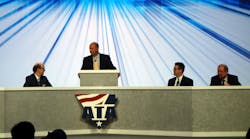SAN DIEGO, CA. Cautious optimism on the economy is turning to plain optimism, and trucking’s solid growth this year is part of the reason, according to a panel of chief economists representing the petroleum producers, retailers and manufacturers as well as the for-hire trucking industry. The one dark cloud is a driver shortage that is “as bad as ever and is expected to get worse in the near term,” according to Bob Costello, chief economist and senior vice president of the American Trucking Assns.
Moderating the annual economists’ update at ATA’s management conference, Costello cited numbers on loads, tonnage, capacity and revenue all reaching pre-recession levels through the first eight months of the year. “Economic growth remains solid” for almost all trucking sectors, he said. “Large carriers are doing well, and small carriers have turned the corner.”
Along with that growth is renewed worries about driver availability. Using driver turnover rates as an indicator of a tight supply, Costello said the annualized rate for large truckload carriers in the second quarter of this year was 103%, up 11% from the first quarter and the highest it’s been since the end of 2012. Small fleets also saw turnover jump 16% over that same period to 94%. Both are creeping up towards all-time high turnover rates seen in 2007 - 136% for large TL fleets and 100% for small fleets.
An aging driver population is one contributing factor to what Costello estimated is a current shortage of 35,000 drivers that is projected to grow to 250,000 by 2023. And despite significant pay increases by many fleets, driver pay has remained stagnant since the recession because overall truckload miles per truck have decreased. “Fleets are paying drivers more, but they’re not getting as much work,” Costello said, pointing to changes in hours-of-service and distribution patterns as contributing factors.
Summing it up for the ATA members, Costello said: “Solid demand, continued tightness in supply, that’s all good news. But watch your bottom line because we could see margin compression as driver pay goes up.”



